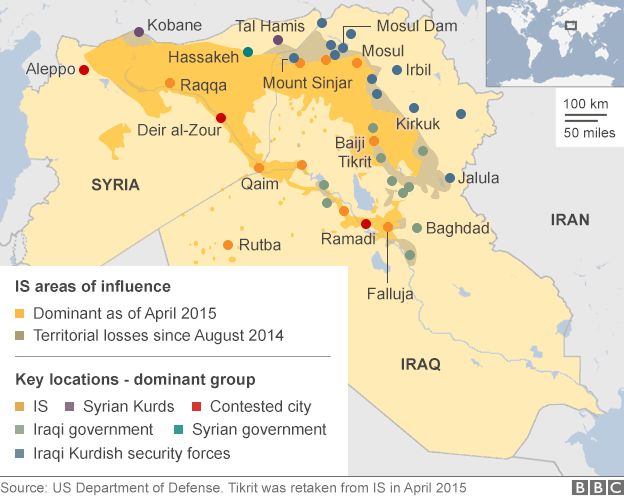
Russian SU-34 bomber
The talks "are likely to take place as soon as this weekend," said press secretary Peter Cook.
There have been concerns that there could be an accidental clash as the two countries pursue separate bombing campaigns over Syria. The US and its Nato allies have also been alarmed at violations of Turkish air space by Russian jets. US and Russian officials conducted talks on air safety via video conference on 1 October, but the US had complained that they had heard nothing from Moscow since then.
Earlier this week, Pentagon officials said they had had to carry out at least one "safe separation" manoeuvre to avoid a US jet coming too close to a Russian aircraft over Syria. They said this happened after 1 October, without giving a specific date.
Talks are likely to deal with how much separation there should between US and Russian aircraft and which language and radio frequencies crews should use for communications.
Talks are likely to deal with how much separation there should between US and Russian aircraft and which language and radio frequencies crews should use for communications.

Russia has said it is targeting positions of so-called Islamic State (ISIS) but there are concerns that it is bombing the rebels opposed to President Bashar al-Assad. Reports on Friday said ISIS had seized several villages near the northern city of Aleppo from rival insurgents.
Russian air strikes seem to be mostly hitting other Syrian opposition forces which pose more of a threat to the Syrian government. The Russian campaign appears to have weakened these groups, and given ISIS the opportunity to push forward, he adds.
US Defence Secretary Ashton Carter on Friday accused Russia of running "fundamentally flawed" operations in Syria which would "inflame the civil war and therefore extremism".
But Moscow has dismissed claims that its week of strikes has mainly hit non-ISIS targets.Russia has also launched cruise missiles against targets in Syria from warships in the Caspian Sea, about 1,500km (930 miles) away.

Syrian troops are said to be gaining ground, helped by Russian air strikes
Mr Carter said there were indications that four missiles that crashed in Iran before reaching their targets in Syria had malfunctioned. Russia has denied that any of its missiles crashed, saying all 26 hit their targets.
In another development on Friday, the US announced it would end efforts to train new Syrian rebel forces and instead shift to providing equipment and weapons to existing forces.
Its $500m program had aimed to train and equip 5,400 fighters this year and a further 15,000 in 2016. However, it emerged last month that only four or five of the fighters were in Syria. It was also revealed that US-trained rebels had handed vehicles and ammunition over to militants. A senior administration official said the program was being put on "pause" and said it could be restarted in future.
RUSSIA'S STRATEGY AND ENDGAME:
Russia's air campaign in Syria has been under way for a little over a week, and it is now possible to begin to analyze what it is achieving, what weaponry is being used and where it may be heading.
Already there are indications that the initial phase is over and that Syrian government forces and their allies may be starting localized offensives on the ground with the support of Russian air power. Ever since the first build-up of Russian forces in Latakia, US analyst Michael Kofman, of the CNA Corporation and a scholar at the Kennan Institute, has been monitoring the air campaign closely. When asked by journalists.......
'Given the number and tempo of Russian air attacks, could he deduce any clear pattern in terms of the nature of the targets and Moscow's broader strategic aims?'
He stated,"Russia's operational tempo is about 20 sorties per day, which is not that intense, but moderate, given the logistics they have in place," he told me. "The targets are known weapon storage areas, ammunition dumps, production facilities, and any command-and-control infrastructure that Syrian intelligence is aware of."
Russia is also softening up opposition forces by eliminating conventional weapons such as tanks, armoured personnel carriers and rocket artillery that they have captured from the Syrian army.
The targets are largely the coalition of groups under al-Nusra Front, to the north by Idlib and Aleppo, along with various rebel groups supported by members of the US coalition near Homs and Hama, to the east of Syrian government positions.
"These are the primary threats to Assad, and the areas where Syrian ground counter-offensives are likely to take place," Kofman says. "The campaign is therefore a softening of these groups and elimination of their weapon caches."
Of course one of the most contentious aspects of the Russian air campaign is precisely who Russian bombs and missiles are targeting? They claim they are attacking
a" variety of terrorist groups". What does that mean ? It is open to interpretation.
So ultimately, the 'endgame', it seems, is keeping Mr Assad in power at any cost.
No comments:
Post a Comment
Through this ever open gate
None come too early
None too late
Thanks for dropping in ... the PICs